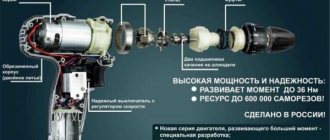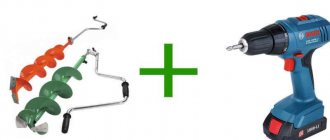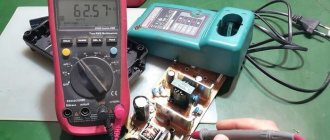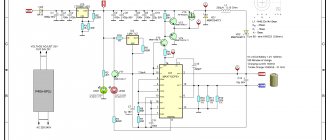The topic of powering a cordless screwdriver from a 220 V network has already been partially discussed on this site.
It was talked about how to select a power supply for a specific model of cordless screwdriver, and tests for tightening screws were shown. No measurements were provided of the current consumed by the screwdriver in various operating modes. This will be discussed further. We will test the same screwdriver :
It will be powered by the same power supply:
First, we measure the no-load current at slow speed:
On the left is the current value in Amperes, on the right is the voltage in Volts.
Then the no-load current at fast speed is:
Now we measure the current at maximum load, when the ratchet operates:
The photo shows a steady value, although short-term surges slightly exceeded 6A. The power supply protection did not work. The resistance of the wires that the screwdriver to the power supply affected it (about 2m).
When the torque control is turned to maximum and the maximum load is applied, when the ratchet no longer works, the engine stops, the current reaches almost 10 A and the power supply is turned off. This is not an acceptable operating mode.
But a stopped motor for the power supply is practically a short circuit. As is known, the short circuit current of a stopped motor is determined by the purely ohmic resistance of the winding and can reach very large values until the power supply protection is triggered. If the power supply is powerful and its protection operates at currents of 20-30 A, then the motor winding wire will burn out. As indicated in the previous article, the maximum motor current of this screwdriver model is 4 A, the diameter of its winding wire is about 0.5 mm.
A current of 10 A is already more than twice as high as permissible, not to mention currents of 20-30 A.
The conclusion is the same, there is no point in having 20-30 A power supplies to power screwdrivers whose motors are designed for a maximum current of 4A. Do not operate the screwdriver while loading it until the engine stops and the ratchet is turned off.
If the screwdriver has a different motor, higher power, with higher currents, then you need to select a power supply for it.
The article material is duplicated on video:
Source: radiomasterinfo.org.ua
Connecting a 12 volt screwdriver to an ATX power supply
Battery screwdrivers are very convenient to use and are widely used by both professionals and home craftsmen. The battery is usually the first to fail. Currently, all manufacturers of power tools have switched to lithium batteries and purchasing a new nickel-cadmium battery for an old screwdriver is becoming more and more problematic, and the prices for these batteries are much higher than for lithium ones.
Of course, it is possible to purchase batteries on various services that sell Chinese goods. But it takes time for the package with the “cans” to arrive, and again, these are certain costs. There is an alternative to buying batteries/cans - connect the screwdriver to the mains power supply and forget about quickly draining the batteries. Powerful power supply on Aliexpress. There are many inconveniences due to the power cord, but you always have to sacrifice something.
Choices
For a home craftsman, the best option would be an inexpensive universal cordless screwdriver with a Li-Ion battery, a keyless chuck and at least a couple of speeds - such a tool is easy to use and can cope with most household tasks.
If you are going to use a cordless screwdriver in a professional activity, choose among models with increased torque and at least a couple of batteries included.
Professional finishers will certainly appreciate a screwdriver for installing gypsum boards - with it, installing sheets of drywall will take a matter of seconds, especially if you choose a model with a tape magazine included.
If you need a tool that will not only tighten screws, but also drill various materials, choose among drills and screwdrivers.
If you work with a screwdriver often, a lot and with a high load, pay attention to a powered tool - if there is an outlet nearby, such a screwdriver may be more convenient, and their prices are lower.
Source
How much current does a screwdriver consume?
Before choosing a suitable power supply, you need to understand what current consumption you need to count on. Unfortunately, cordless screwdriver manufacturers do not indicate the current consumed by the motor. The capacity of the battery itself in ampere-hours, which is necessarily indicated on the battery, does not allow us to understand how much current the screwdriver consumes in operating mode
. The maximum that the manufacturer can indicate is the power in watts, but this is very rare, usually the power is indicated directly in torque.
If the power in watts is still indicated, we can have an idea of the current consumption and select an appropriate power supply with a small current/power margin. To calculate the current, it is enough to divide the power in watts by the operating voltage of the screwdriver, in this case it is 12 volts. So, if the manufacturer indicated a power of, for example, 200 watts - 200_12 = 16.6 A - this is the current consumed by the screwdriver in operating mode.
However, the indicated power is very rare and there is no universal figure that characterizes all 12-volt screwdrivers. You need to understand that when the motor shaft is fully braked, the currents can significantly exceed the rated ones and calculating this value is not very easy. At the same time, an analysis of various forums and our own experience has shown that a current of 10 A is often sufficient to operate a screwdriver; this is enough to perform many screwing and drilling functions. It is known that current surges during complete braking of the shaft can exceed 30 A.
Well, what conclusion can be drawn from all this? A 12 V power supply providing 10 A current is suitable for a screwdriver; if it is possible to use a 20-30 A unit, this is even better. These are average figures that apply to most screwdrivers.
Household or professional
As you know, professional screwdrivers are more expensive, but this is no coincidence. They are made with a large margin of safety, for which higher quality and more expensive materials are used. In addition, they have more power, which makes it possible to screw in longer screws and/or work with tougher materials.
The difference between a professional and household screwdriver in resource
To decide whether you need a household or professional screwdriver, assess the amount of work that will need to be done. If you are starting construction or major renovations, you probably need a professional or semi-professional model. If you need a tool periodically to unscrew/tighten something from time to time, a household tool is more than enough. With such work, the professional tool resource simply will not be in demand. So choosing a screwdriver based on this criterion is not very difficult.
power unit
We will not consider purchasing any units or transformers, and if we do buy it, it will be a new battery! We will consider using what we have on hand. I’ll say right away that the charger from the same screwdriver is only suitable for drilling overripe bananas, its power is too low.
Ideally, a step-down, powerful 12 V transformer, for example from a computer uninterruptible power supply, would be suitable. The power of such a transformer is usually 350-500 watts. But I didn’t have such a transformer, but I had a lot of computer power supplies. I am sure that if someone has various electronic junk, ATX computers are definitely lying around in it.
The computer ATX unit is quite suitable for a screwdriver; the load capacity on the +12 volt bus allows you to remove currents of 10-20 amperes. I would like to dispel a small myth - it will not be possible to stuff the unit into the battery housing of a screwdriver, the ATX board is too large. You will have to make a separate case for the block or leave it in its original metal case. The disadvantage of the original case is sensitivity to dust, and even the smallest repair requires a lot of dust.
Mock Tests
Before starting to build a working structure, you should test everything on the knees, make sure that the screwdriver is operating stable under load and that there is no severe overheating in the power supply.
We take the computer power supply and check it: plug it into the network, find green in the output bundle of wires (they say it can be a different color, but I always came across green ones) and connect it with a jumper to any of the black ones (all black wires at the output are the common output, in our case it is a minus). The unit should turn on and a voltage of 12 volts will appear between the black and yellow wires. You can check this with a multimeter or by connecting any computer cooler to the named terminals.
If everything is in order and the unit produces about 12 volts on the yellow (+) and black (-) terminals, continue. If there is no voltage at the output, we look for another unit or repair this one; this separate topic will be described separately.
We cut off the plug from the output of the block and take 3-4 yellow and black wires coming from the block and connect them in parallel. When cutting off the plug, do not forget about the green starting conductor, it must be shorted to black. We received a 12 V source with a decent current load capacity of 10-20 A, the currents depend on the model and power of the unit.
Now we need to connect our 12 V to the terminals of the screwdriver without a battery; we look at the polarity of the connection using the battery. Well, we check the screwdriver - at idle speed, then slowing down by hand. At this stage, I encountered a problem: when I press the button fully, the screwdriver works, but when I slowly, smoothly press the screwdriver button, the power supply goes into protection. To reset the protection, you must disconnect the unit from the network and turn it on again. This won’t work at all, we need to somehow correct this instability.
Additional functions
As usual, these functions are not mandatory, but they significantly increase ease of use. Some, if they raise the price, do not raise it significantly, while others raise it quite significantly. To choose the most inexpensive screwdriver, you can get by with the minimum - reverse and the presence of illumination of the work area. The rest, of course, are useful, but are more suitable for professionals.
Some additional features are very useful
Reverse or reverse
The presence of this option allows you to unscrew a screw or drill stuck in the material. The direction of rotation changes when the polarity of the power supply changes, which is done through a special button. It is usually installed near the trigger lever.
Examples of the location of the reverse button in a screwdriver
Most often, the button for switching the direction of travel has three positions: on average, the tool is blocked. This increases safety: if you accidentally touch the lever, the screwdriver will simply stop, rather than immediately start rotating in the opposite direction.
Work area lighting
A very convenient option that does not greatly affect the price of the screwdriver is illumination of the work area. With good lighting it is much easier to control the instrument.
Illumination of the work area is a useful additional function of a screwdriver
An LED is built into the handle or body of the tool near the chuck, which lights up when the start button is pressed. If you want to choose a screwdriver that is convenient to work with, make sure that the work area is illuminated.
Battery indicator
If you decide to choose a cordless screwdriver, it would be a good idea to have a battery charge indicator. These are LEDs of different colors - green, yellow, red, which are located on the body. If the light is green, the charge is full; if it is red, the charge is almost empty.
Battery indicator
The location of the indicator depends on the company, but is usually located on the thickening of the handle, in the same place as the backlight LED, or in the upper part of the case.
Automatic feeding of screws
Such screwdrivers are also called shop screwdrivers. This option is useful for professionals, especially those who work with drywall, where fasteners must be installed in small increments. Self-tapping screws are attached to a special tape, tucked into guides, and automatically fed into the holder.
Screwdrivers with automatic fastener feed
This option can be implemented in two ways: there are store-bought screwdrivers (pictured on the left) and there are attachments for a regular screwdriver. For home use, the second option is preferable, since the tool can work as a drill or in reverse. A shop screwdriver is highly specialized equipment for professional use.
Source
Assembly of the working structure
For ease of use and connection, I brought the cord from the power supply into the battery case. I took a 3.5 meter long cord that was available. I removed all the battery cells from the battery and installed an LC filter. Now, if I somehow get a working battery, I can always put it on a screwdriver and put the power supply away as a reserve. I didn’t throw the batteries out of the battery, I have an idea where to use them, but that’s a topic for another review.
Since the cord connecting the unit to the screwdriver has a certain resistance and inductance, you can try to close the terminals of the L1 coil with a jumper. In theory, this could increase power by a tiny amount.
The screwdriver feels great with a cord, but to be honest, it seemed a little weak to me when braking by hand. But trial tightening of the self-tapping screws dispelled my doubts: self-tapping screws 35 mm long can easily be screwed into 20 mm plywood. This means that a screwdriver will cover most repair needs.
I cut off all the output wires from the block, leaving the green starting wire; I soldered its end to the common conductor of the board, where all the black ones are soldered. It's best to carefully desolder all the wires, but my soldering iron was too weak for this and had to be cut. I soldered two short, hard copper wires to the common contact and +12 (where the yellow ones are soldered) and connected them through the terminal block to the cord to the Shura.
This is where we will finish this review; we have achieved what we wanted - the screwdriver works perfectly with a computer power supply. In the future, I plan to make a high-quality plywood case without cracks for the power supply board - tests have shown that the heatsinks on the board do not heat up at all and you don’t have to worry about overheating of the elements in a closed case.
Types of screwdrivers
Depending on the tasks and parameters to be solved, all screwdrivers are divided into professional and household models.
Household
A household screwdriver has relatively low power and short service life. They are great for working on soft materials (wood, plasterboard, MDF, chipboard, etc.). But they cannot be used for a long time. Such models are chosen to solve various one-time household tasks - assembling furniture, installing a lock, blinds, shelves and other elements of the home interior.
Professional
A distinctive feature of professional models is a long period of operation, in comparison with household ones. They can perform their functions for 5 – 8 hours a day every day without loss of performance. Also, in addition to the standard unscrewing and tightening of self-tapping screws, they are equipped with the function of drilling metal, concrete and wood. For drilling concrete, professional tools are equipped with a hammer mechanism.
Few additions
To compensate for losses in the cord connecting the screwdriver to the power supply, it is useful to increase the voltage by 2-3 volts. But this is provided that you know the circuit design of ATX computers and know what to do.
If it is possible to use a powerful transformer, then its output, secondary winding should have an alternating voltage of 12 V. If the voltage is different, it is recommended to adjust the secondary winding by unwinding (if the voltage is more than 12 V) or rewinding (if less than 12 V) several turns. It is worth noting that when rectifying and filtering the 12 V AC voltage, it turns out to be about 14.4 V without load. So don’t let this confuse you, this is the EMF voltage and it is natural that it is higher than the nominal one.
In addition to the transformer, a rectifier is assembled; the diodes should easily hold 30 A. It is more expedient to place the capacitor filter in the battery case, as in the ATX version.
Source: yserogo.ru
We transfer the screwdriver to power supply from the 220 network
If you have a screwdriver and mainly use it indoors, then I think you will find this article interesting and useful. Here we will talk about converting a 12 volt screwdriver with a ni-cd battery.
It would be a good idea to power a screwdriver for your home from an outlet. That's what we'll do today.
A logical question arises: is there any point in redoing anything at all? So aliexpress will not help us in solving this problem. Therefore, I want to offer you another option that is several times more profitable.
Computer power supplies are pretty powerful guys. Also, finding such a power supply will not be difficult. You probably have something like this lying around at home, unused. And if not, then you can go to any computer repair shop and buy a used power supply for a couple of hundred rubles, say, 500 W.
Let it be wrinkled, dirty, covered in dust, but the main thing is that it works. There is usually a sticker on one of the walls containing detailed information on the power lines. On this block we can see the following characteristics: 25 A per 12 V line, and this is no less than 300 W of power.
Enough for a screwdriver. Such a power supply is of course quite large, but at the same time it is much cheaper even than Chinese units with lower power.
You will need to solder a wire with a cross-section of, say, 3 mm 2 to these terminals. In theory, this should be enough to ensure that the energy does not dissipate into heat, even over a wire length of about 2 m. We take a soldering iron and, having previously prepared the wires (by stripping them of insulation and irradiating them), solder them to the terminals.
I don’t know how it will work with your screwdriver; personally, the author managed to bend the terminal ears directly into the plastic and it turned out very reliably.
Supporting it from below, for example, with a screwdriver, we drill a hole through with a drill with a diameter of 3 mm. Then we remove the chamfer with a large drill. Moreover, we remove it so that the m3 screw with the countersunk head does not stick out.
Well, all that remains is to tighten the nut. This option with a screw is many times better than any other fastening.
Also, it is highly advisable to place a 16 or 25 V capacitor with a capacity of about 10,000 μF in parallel with the terminals. You can buy a capacitor at any radio market, in any radio goods store, or you can also pull it out of a dead computer unit. There is a way to get such a capacitor for free. Most likely they will give it to you for free at any computer repair service. They throw them out anyway. You just have to ask. So take action.
The capacitor will serve as an energy buffer for inrush currents. This is necessary in order to reduce the load on the power supply. If this is not done, with a high degree of probability it (the power supply) will go into protection. We take it and solder it. In this case, the author recommends gluing the nut with superglue. Otherwise you simply won’t be able to tighten it.
Well, let’s finally check the torque ratchet at maximum mode to make sure that the power supply draws the maximum starting current in the ratchet screwdriver mode.
And everything is fine here too. The defense didn't work. The experiment can be considered more than successful.
And finally, if you take a weak power supply and it goes into protection, but you have already installed a capacitor, the voltage protection is most likely triggered. And oddly enough, the problem is solved by additional load on the 5 V power line. That is, we take the red and black wires and connect a separate load to them. On the forums they write that 1 A will be enough. To do this, take a 5 W 6 V bulb or two 3 W bulbs, and let them just shine and load the line and everything will work great.
Screwdrivers: The lower the Volt, the greater the power?
Dear craftsmen, after reading a little about cordless drills (screwdrivers), I was sure that the power of a screwdriver directly depends on the “number of volts” in the battery. Those. I was sure that an 18 volt screwdriver is more powerful than a 12 volt one. However, in reality this turned out not to be the case. Got a question:
Why do branded screwdrivers provide significantly more power at a lower battery voltage?
Compare Interskol and AEG:
3100 rub. Technical characteristics: Rated voltage: 18 V Rotation speed: 0-400 / 0-1100 rpm (1/2 speed) Number of torque control stages: 16 Max. drilling diameter: - in metal 10 mm - in wood 18 mm Weight: 2.0 kg Number of torque adjustment stages: 16 Maximum torque: 16 / 9 Nm (1 / 2 speed) Battery type: NiCd Battery capacity: 1.5 Ah
3600 rub. Technical characteristics: Battery voltage 12 V Battery capacity 2.0 Ah Idle speed in 1st/2nd gear 0-380/0-1300 rpm Torque: soft/hard connection 16/35 Nm Static torque in 1st 1st / 2nd gear 38/15 Nm Keyless chuck 1.0-10 mm Max. drilling diameter in steel/wood 10/30 mm Wood screws up to 8 mm Weight with battery, keyless chuck 2.0 kg
It turns out that with a price difference of 400 rubles, AEG with 12 V is more than 2 times more powerful than Interskol with 18 V. If the difference in price was 2 times, then I would understand.
Explain, please, what is the reason? Is this the market nuts playing tricks again?
PS: I personally have nothing against Interskol.
Didn’t see where it’s more powerful? This eternal topic (they say it is now allowed, but I don’t know) is about measuring the rotating torque (they measured it in different ways: hard, soft, long-lasting, maximum). Plus, a number of manufacturers indicate not maximum, but long-term performance characteristics. I can note the influence of the quality of the underlying design developments (the same gear ratio and its calculation will affect the number of screwed-in “nails”) and materials (reliability of the engine and battery under overload). At some presentation in 2001, a long (about 20 cm) capercaillie 10 was screwed into a pine tree using a Metabo BST 12i screw. Screwed it in, poor fellow. If this is written in the technical specifications, he will not live even a day
Besides. Voltage, of course, has an indirect effect on Shurik’s power. and as a rule, higher voltage means more powerful. But not always - there are low-voltage screwdrivers with a powerful engine (Protool 10.8-volt), and there are high-voltage screwdrivers with a weak engine (Festool T15+3)
littorio wrote: there are low-voltage screwdrivers with a powerful engine (Protool 10.8-volt), and there are high-voltage screwdrivers with a weak engine (Festool T15+3)
Everything depends on the winding, its thickness, etc. etc. Motor power = current consumption X voltage.
SMT wrote: I was sure that the power of a screwdriver directly depends on the “number of volts” in the battery
It is so indeed. Almost. In fact, it's like this:
- come from accumulating elements. They can deliver maximum current.
- the more elements in the battery, the greater the maximum power that can be taken from it (at maximum current, of course)
- The higher the current, the thicker the wires are required, which also limits the possibility (and cost) of creating low-voltage, high-current motors. So everything is just enough. At low voltage, more power can be achieved by simultaneous use of more powerful batteries (high-current) and more expensive engines. Sometimes they do this if weight is critical. Increasing power by increasing the number of elements in the battery means increasing weight.
kluchnik wrote: Didn’t see where it’s more powerful?
I meant the torque that Interskol has: “Maximum torque: 16/9 Nm (1/2 speed)” - it is MAXIMUM. And AEG generally has 4 indicators, but it seems to me that Interskol meant the one that AEG has “Static”.
npn wrote: So everything is just enough. At low voltage, more power can be achieved by simultaneous use of more powerful batteries (high-current) and more expensive engines. Sometimes they do this if weight is critical. Increasing power by increasing the number of elements in the battery means increasing weight.
If they install more expensive engines and powerful batteries, then the price should be “more expensive”.
In reality, it turns out that the weight is the same, the price is comparable, the power differs by 2 times.
This is what I can’t wrap my head around. It feels like I'm being deceived.
Or AEG with its cunning measurements. Or Interskol with a price setting.
Then one question remains: Who is deceiving me?
npn wrote: This is true. Almost. In fact, it's like this:
- come from their accumulating elements. They can deliver maximum current.
- the more elements in the battery, the greater the maximum power that can be taken from it (at maximum current, of course)
- The higher the current, the thicker the wires are required, which also limits the possibility (and cost) of creating low-voltage, high-current motors. So everything is just enough. At low voltage, more power can be achieved by simultaneous use of more powerful batteries (high-current) and more expensive engines. Sometimes they do this if weight is critical. Increasing power by increasing the number of elements in the battery means increasing weight.
What does engineering education mean? npn explained everything thoroughly.
SMT wrote: If they install more expensive engines and powerful batteries, then the price should be “more expensive”.
In reality, it turns out that the weight is the same, the price is comparable, the power differs by 2 times.
This is what I can’t wrap my head around. It feels like I'm being deceived.
This is true. Where have you seen people who are not interested in the benefits of deceiving the buyer? In general, there are many factors here. Manufacturer purchasing lots, if for example IS orders 100,000 engines, and BOSCH orders 10,000,000, it is clear that the price for BOSCH will be less.
2SMT power, of course, is not twice as different. But the price is strange. There should be a greater difference in price.
I look in the Dewalt catalog there are 18 14.4 12 V XRP 450 W 350 W and 310 W output on the spindle, and at the same time simple drills 375, 295 and 240 W output. A completely logical conclusion arises: not only the voltage but also the drive will determine the power.
SMT wrote: Please explain what is the reason?
It is not very correct to compare screwdrivers of different voltages, since not only the torque differs, but also the operating time on one charge.
And you indicated the average price for Interskol, and the lower one for AEG, the average price for AEG is 4035 rubles.
Here are the links to Yandex Market:
As for the torque, I don’t know what torque AEG gives, since there is a practice when the maximum torque from the datasheet for the engine is simply taken and recalculated through the reduction coefficient, of course, batteries do not carry such currents and these moments are unattainable in real life, and Interskol conducts real tests on a torque tester and is responsible for its data.











